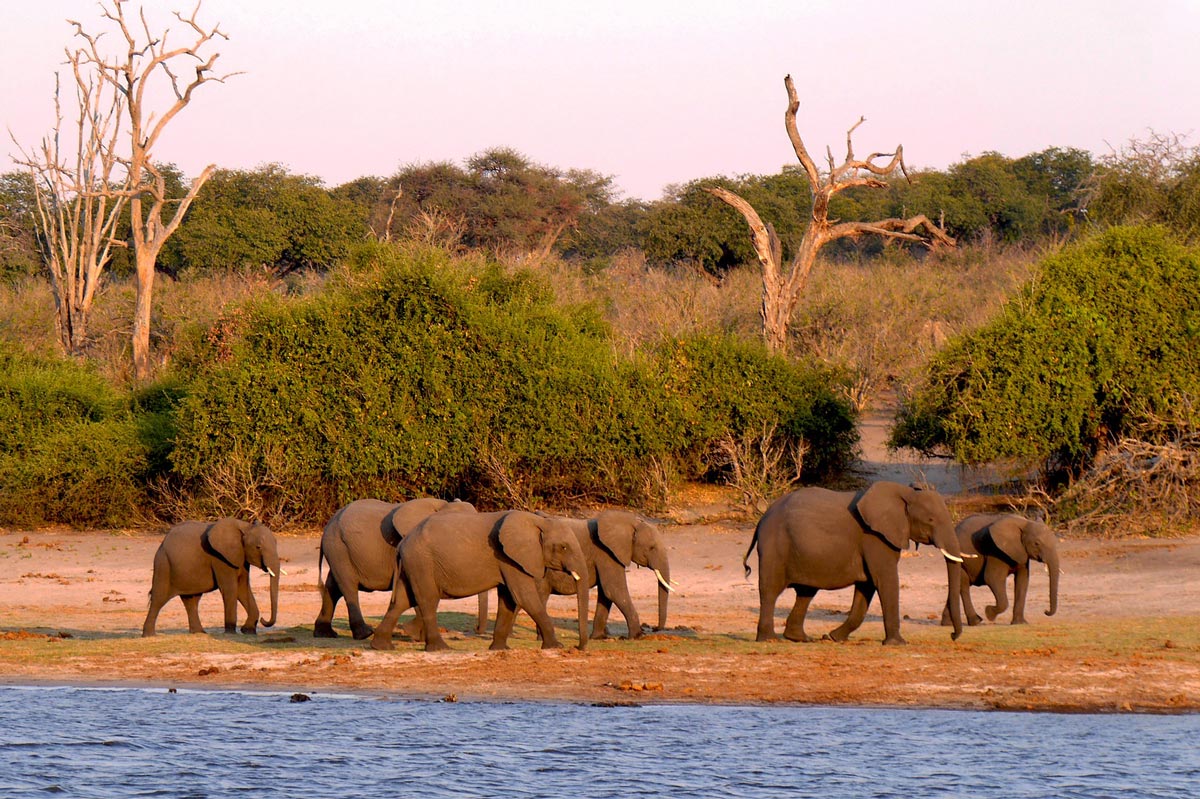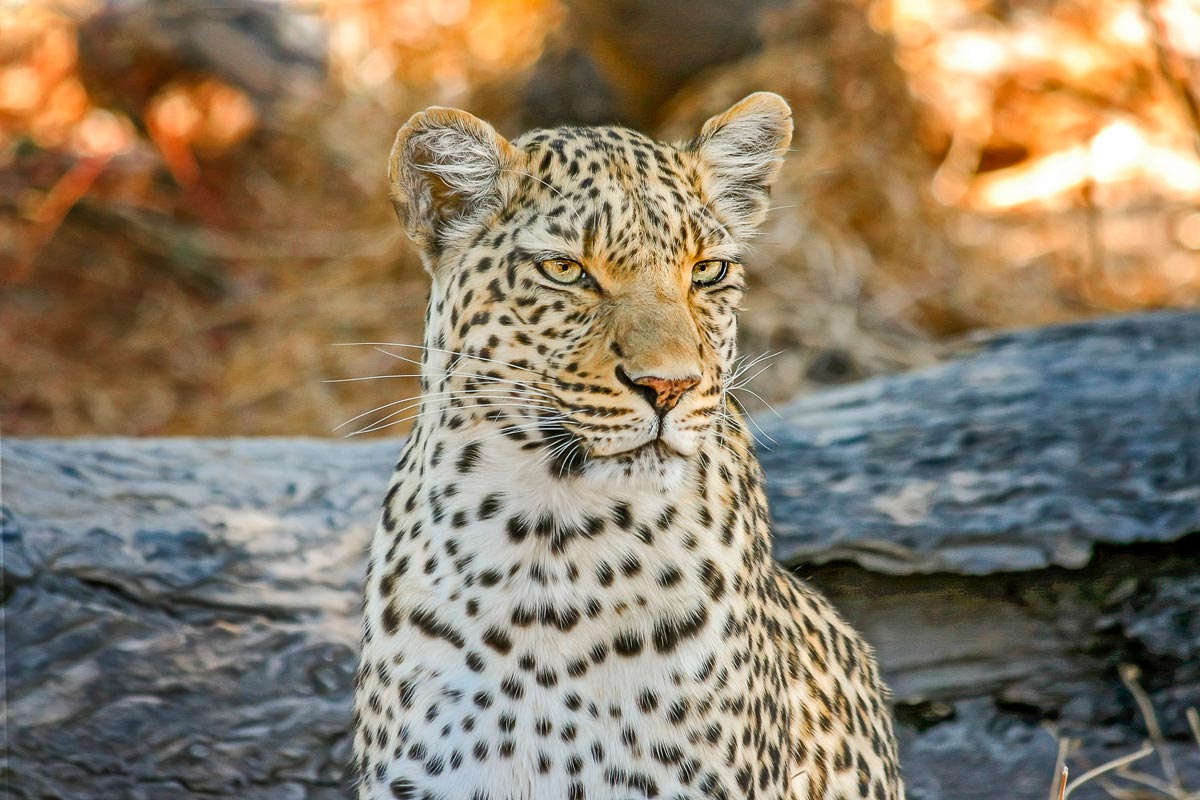Botswana
Zambia
Zimbabwe
Namibia
Botswana is a landlocked, semi-arid country, covering an area of 581, 730 square kilometers (roughly the size of France or Texas), with a population of just over 2 million people. She shares borders with South Africa in the South, Namibia in the North West, Zambia in the North and Zimbabwe in the North East.
Botswana gained its Independence on the 30th September 1966, and still enjoys a stable democratic form of governance. She is ranked one of Africa’s most peaceful countries and has received numerous international accolades to this effect.
With Tourism being the second largest industry in terms of the Gross Domestic Product and one of the fastest growing industries, the Botswana Government formulated a sound conservation policy by setting aside 38% of the country for environmental conservation purposes.
Where to go in Botswana?
Embark on a trip with us at Travel Galore, (whether a mobile safari, fly in lodge-based safari, self-drive safari or a combination of two or all three), and share with us the ever so diverse topography of Botswana throughout areas such as:
The Chobe District in the Northern tip of Botswana is made up of settlements/small villages stretching from the North-Eastern tip of the Moremi Game Reserve through to the North Eastern tip of Botswana. The district houses the world famous Chobe National Park and Chobe River.
The Chobe National Park at 10, 698 square km, is the third largest national park in Botswana, after The Central Kalahari Game Reserve (CKGR) and Kgalagadi Transfontier Park (KTP) respectively. Chobe National Park is well known for its high elephant population, as well as an abundance of other animal species from, predators, antelope, to the ever impish primates, and general game.
The Chobe River, originates in Angola and flows through to Mozambique (all the while changing names throughout the different countries), and is home to many fish species, hippos & crocodiles, a breeding ground for numerous birds, and a much appreciated feature/sanctuary for most dry land animals especially in the hot and dry seasons, as it is this source that they use to quench their thirst as well as splashing in the water to cool off, when temperatures are souring.
To a lot of people’s disbelief, the world’s largest inland Delta is smack in the middle of the Kalahari sands. Another lesser known fact is that the world famous Moremi Game Reserve forms part of this beautiful oasis. Botswana’s Okavango Delta is fed by waters from the Okavango River which originates from Angola.
The Okavango Delta covers a total area of 17, 000km square, inclusive of the Moremi Game Reserve.
The Delta is a wonderful water hole for both water animals, ie, otters, crocodiles, hippos, fish, general land game as well as birds and extremely rare animal species like the ever elusive Sitatungas.
This amazing animal sanctuary is situated in the heart of the Okavango Delta, in the Ngamilnd District and covers a total area of 4, 871km square.
The Moremi Game Reserve boasts a wide diversity of both flora and fauna. Over and above general game such as Giraffe, Zebra, Antelope, this reserve is the only place in Northern Botswana that has White Rhino. Predators are also commonly seen in this reserve.
The reserve also offers great bird watching for the keen birders, with species such as the very sought after Pels Fishing Owl.
Large open spaces….total nothingness….breathtaking African stars and a cluster of one of the world’s biggest trees in diameter….this pretty much sums up the beauty and uniqueness of both Makgadikgadi and Nxai Pans.
The Pans are well known for their bone dry surface in the dry/winter season, but transform to spectacular large basin of water, which appears as a sea, during the rainy season. During the wet season, the amount of birdlife in this part of Botswana is unbelievable, with the most common species being the flamingos, in droves.
The Makgadikgadi Pans remain one of the most serene places in Southern Africa, where one could actually pull out a mattress and sleep out in the open, being serenaded by the beauty of the clear African sky, and the visually bright African stars. The Nxai Pans on the other, offer a spectacle that one has to witness….a cluster of the great Baobab trees. Activities to be enjoyed in the Pans are: quad biking, game drives, nature walks and birding.
The 52 800 km square CKGR, as it is fondly known is situated in the heart of Botswana. The Reserve is characterised by pans, valleys and open plains. It is known well known for being home to different species of antelope and big cats.
This part of Botswana offers the visitor a chance to experience one of Botswana’s oldest cultures: the Basarwa. CKGR is also known for its extreme temperatures: icy cold in the winter and scorching hot in the summer. Game Drives and Village walks are activities that can be enjoyed in this reserve.
Maun, the gateway to the Delta is predominately a Tourism based, cosmopolitan town. This town accommodates a host of Safari Companies, a lot of which have luxury camps in the Okavango Delta, Linyanti and Makgadikgadi.
This town has come a long way, from days of dusty roads, a few government schools, one filling station, Maun now boasts a state of the art referral Hospital, private clinics, multi-racial schools, numerous supermarkets, international store brands, tarred roads and street lights. Maun airport has served the industry well, with light aircraft charters ferrying visitors in and out of our tourist destination, ie, Okavango Delta, Linyanti, Tsodilo Hills, CKGR etc.
Maun offers plenty of excitement to both local residents and visitors. One can enjoy the many animals that Maun Educational Park offers, the crocodile farm, cultural living, basket weaving, the Nhabe Museum, Horse-riding, the annual Maun Arts & Culture Festival hosted here every April or May, or simply a shopping spree at some of the most well stocked curio shops that mainly sell Botswana produced wares.
Botswana’s only World heritage site, the sacred Tsodilo Hills was initially inhabited by the Basarwa who have left us a piece of history that we are so proud to share with our visitors, in the form of ingenious rock paintings.
The Tsodilo Hills are a long stretch of 3 detached Hills known as the Female, Male and Child Hills. The Child Hills are the smallest of the 3 and are situated north of the female Hills, The Female Hills are the biggest and are situated in the centre and The Male Hills are the second biggest and are situated south of the Female Hills.
A lot of these ancient painting are pictures of both wild and domestic animals. The one and only way to enjoy the Hills is by walking and there are demarcated trails throughout the 3 Hills. Souvenirs (usually beautiful jewellery made from ostrich eggshells) can be purchased on site from the local inhabitants of Tsodilo.
Located in the North-Western part of Botswana, Qchwihaba Caves are every explorer’s/adventurer’s dream come true. Exploring these caves one has to be prepared to share some parts of the caves with the resident bats.
Formation of the intricate fragile rocks within the caves has happened over thousands of years, and the aforementioned rocks are extremely sensitive. Though one is tempted to take it all in by way of caressing or simply feeling the rocks, this is unfortunately not permitted for preservation purposes. Some areas of the cave are fairly easy to walk through, but there are other sections of this marvel that are challenging to manoeuvre. The visit to the caves is nonetheless an adventure not to be missed in the Botswana circuit.
Nestled in the corner of North Eastern Botswana and one of the largest privately owned game reserves in Southern Africa (71,000 hectares), the Tuli Block is one of Botswana’s best-kept secrets. Wildlife is a big attraction, with about 48 species of mammals and over 350 species of birds.
The landscape, which is unlike anywhere else in Botswana is an attraction on it’s own, with its moonscapes of muddy oranges and browns, its hills overlooked by deep-blue skies. For active safari travellers, can enjoy hiking, biking, horse-riding, hot-air ballooning as well as game drives.
The Tuli is any archaeological dream, with sites that provide an important historical perspective to the region. Iron Age sites demonstrate the formidable skills in pottery, mining, and smelting of the the natives who practised agriculture and animal husbandry in the area many years ago.
The capital city of Botswana, Gaborone (which means “not unbecoming) was named after Kgosi Gaborone of the Batlokwa people who migrated from the Magaliesberg Mountains in South Africa and settled in Tlokweng, a village which is literally within the city.
As any city, Gaborone offers a few locations for entertainment, business and lifestyle, (shopping malls, clubs, restaurants, world-class conferencing facilities, cinemas as well as local and cultural activities.) Easily accessible via flying and driving from South Africa, and in close proximity to game reserves, local villages, it is the most ideal location for both the business traveller and typical tourist.
Beyond Botswana
Zimbabwe covers a total area of 390, 757 square kilometres. Like Botswana, Namibia and Zambia, Zimbabwe’s official language is English. Just a stones throw away (70km) from Kasane, Chobe lies the Victoria Falls town, that houses the mighty Victoria Falls, shared between Zimbabwe and Zambia. This tourist town has a wide range of activities on offer , ie, Bunji jumping, White Water Rafting, craft centre shopping, traditional dancing, a night of partying at a few of the hotel based night clubs, and a host of other attractions.
Zambia fondly referred to as Africa’s last Eden is a land locked country north of Botswana. This democratic Southern African country gained her independence from the United Kingdom in 1964, and has a population of 12 million people, and like her neighbours, Botswana and Zimbabwe, this country has an abundance of natural resources, ie, wildlife, the mighty Victoria Falls and a very rich cultural heritage, with more than 72 different tribes in the country alone. Zambia is one of the countries that shares her borders with 3 other countries (Botswana, Namibia and Zimbabwe), at one point, the Chobe confluence, the only place in the world that has this unique attraction.
Namibia is a true Desert and Delta country. A large portion of the country is desert, and yet one can also enjoy the cool waters of the Atlantic Ocean, that stretch throughout the North-Western to the South-Western tip of the country. Namibia gained her independence from South Africa in 1990, and like Botswana, Zambia and Zimbabwe, she’s part of The Southern African Development Countries (SADC). Namibia’s rich tourism attractions include, but are not limited to: The Skeleton Coast, Etosha National Park, Caprivi Strip, Sossusvlei, Walvis Bay and Swakopmund.



